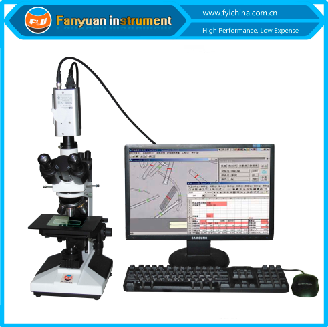Specifications to Look for in an Optical Fibre Diameter Analyser Device
Enhance Your Fiber Optic Projects With an Efficient Diameter Analyser
The assimilation of an effective size analyser right into fibre optic projects serves as a pivotal component in accomplishing precision and uniformity. By facilitating exact size measurements, these analysers not only enhance the quality of setups but likewise minimize prospective compatibility concerns among parts.
Importance of Diameter Dimension
Gauging the diameter of fiber optic cords is a critical task that makes certain optimum efficiency and reliability in communication systems. Precise diameter measurement is important for various reasons, largely for maintaining signal integrity and decreasing loss. A cable's size straight affects its ability to transmit light effectively; variances from the specified diameter can lead to raised attenuation, which influences the general performance of the network.
Additionally, accurate measurement is critical throughout the installation and upkeep of fibre optic systems. An improper fit between wires and ports can result in signal deterioration or total failure of interaction web links. By ensuring that diameters are within defined resistances, professionals can boost compatibility in between components, bring about enhanced system reliability.
In enhancement, diameter dimension plays a significant duty in high quality control throughout manufacturing. Uniformity in the diameter of fibre optic cords is crucial for making certain consistent efficiency across different sets. optical fibre diameter analyser. This consistency aids manufacturers preserve sector standards and cultivates self-confidence among end-users
Attributes of an Effective Analyser
An effective analyser for fibre optic jobs must include a number of key functions that boost accuracy and functionality in size dimension. High-resolution optical sensors are important for exact size readings, making it possible for individuals to detect also the least variants in fibre density. These sensors ought to be matched by sophisticated calibration systems, guaranteeing constant performance across different problems and materials.
Second of all, an easy to use user interface is crucial for facilitating simplicity of operation. This consists of user-friendly software application that permits smooth data input and result, along with graphes of the dimensions taken. A mobile design enhances usability in numerous area atmospheres, making it less complicated to perform assessments on-site.
In addition, the analyser ought to sustain multiple dimension settings, fitting different fiber kinds and applications. The ability to store and obtain historical information is another vital attribute, permitting customers to track efficiency over time and make informed choices.
Benefits for Fibre Optic Projects
Implementing a size analyser in fibre optic jobs provides considerable benefits that significantly improve job efficiency and quality. Among the main benefits is the ability to ensure specific measurements of fibre size, which is essential for keeping optimum efficiency in fibre optic systems. Precise diameter analyses assist in the recognition of inconsistencies that can bring about signify deterioration or loss, thus ensuring premium transmission.
Additionally, making use of a size analyser enhances the quality assurance process. By automating dimension tasks, project groups can reduce the moment invested in manual examinations, causing faster job conclusion and minimized labour costs. This performance likewise allows for even more rigorous screening procedures, resulting in improved product integrity.
Furthermore, consistency in fiber diameter dimensions advertises compatibility with various other fibre optic parts, minimizing the threat of installment browse around this site errors and boosting total system performance. The unification of a diameter analyser not only help in maintaining industry standards however also promotes self-confidence in task deliverables.
Integration Into Existing Process
Integrating a diameter analyser right into existing operations can significantly improve the functional efficiency of fibre optic projects. By seamlessly integrating this technology, teams can attain specific measurements that are important to preserving the integrity and efficiency of fibre optic systems. This integration permits real-time data collection and analysis, which can be important throughout the manufacturing and installment stages.
In addition, the capability to automate diameter measurement processes decreases the potential for human error, making sure regular quality assurance throughout the task lifecycle. The data generated can be easily shared across platforms, assisting in collaboration among designers, professionals, and job supervisors. This ease of access boosts decision-making and accelerates project timelines.

Picking the Right Size Analyser
When selecting a diameter analyser for fibre optic projects, it is vital to consider several vital variables that directly effect measurement precision and functional effectiveness. The resolution and accuracy of the analyser must straighten with the certain requirements of your task. Higher resolution instruments can discover minute variations in diameter, which is important for ensuring optimal performance Related Site in fiber optic systems.
For projects with tight target dates, a diameter analyser that provides quick information procurement can considerably boost productivity. In addition, consider the analyser's compatibility with existing systems and software program.
One more crucial element is the range of sizes the analyser can accommodate. By meticulously assessing these variables, you can choose a diameter analyser that enhances the performance and precision of your fiber optic tasks.
Conclusion
Finally, the combination of an effective diameter analyser is critical for improving fibre optic tasks. Specific size measurements ensure ideal performance and dependability while reducing setup mistakes. Advanced functions assist in real-time information collection and conformity with market requirements, eventually boosting the high quality of deliverables. By prioritizing the option and application of a proper analyser, job effectiveness is dramatically enhanced, leading the way for effective outcomes in fiber optic applications.
A cord's diameter directly affects its capacity click now to send light properly; inconsistencies from the specified size can lead to raised depletion, which impacts the general performance of the network.
